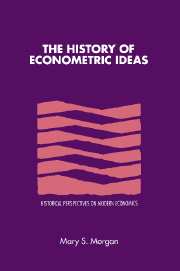Book contents
- Frontmatter
- Contents
- List of figures
- Preface
- Acknowledgements
- Introduction
- Part I Business cycles
- Introduction to business cycles
- 1 Sunspot and Venus theories of the business cycle
- 2 Measuring and representing business cycles
- 3 Random shocks enter the business cycle scene
- 4 Tinbergen and macrodynamic models
- Part II Demand analysis
- Part III Formal models in econometrics
- Conclusion
- References
- Index
4 - Tinbergen and macrodynamic models
Published online by Cambridge University Press: 26 October 2009
- Frontmatter
- Contents
- List of figures
- Preface
- Acknowledgements
- Introduction
- Part I Business cycles
- Introduction to business cycles
- 1 Sunspot and Venus theories of the business cycle
- 2 Measuring and representing business cycles
- 3 Random shocks enter the business cycle scene
- 4 Tinbergen and macrodynamic models
- Part II Demand analysis
- Part III Formal models in econometrics
- Conclusion
- References
- Index
Summary
Jan Tinbergen built and estimated the first macrodynamic model of the business cycle in 1936. Amongst all the econometricians of his day, Tinbergen was ideally suited for such a task. He had been experimenting with small-scale models of the trade cycle since the late 1920s and was well versed in the ways of dynamic models. He also had a wide knowledge of quantitative business cycle research from his experience as Editor of De Nederlandsche Conjunctuur (the Dutch statistical business cycle journal). Yet, even for one so well qualified, it was a formidable undertaking, for there was a considerable jump from putting together a small cycle model to constructing an econometric model of the business cycle covering the whole economy, and Tinbergen was well aware that the difficulties were not merely due to the difference in scale.
Tinbergen had already given considerable thought to the problems involved in a 1935 survey of econometric research on business cycles commissioned for Econometrica. He had taken as his starting point Frisch's (1933) idea that a business cycle model should consist of two elements, an economic mechanism (the macrosystem):
This system of relations defines the structure of the economic community to be considered in our theory
(Tinbergen (1935), p. 242)and the outside influences or shocks. But, as Tinbergen had pointed out, this was only a basic design for an econometric model; the scope of Frisch's new term ‘macrodynamics’ was unclear.
- Type
- Chapter
- Information
- The History of Econometric Ideas , pp. 101 - 130Publisher: Cambridge University PressPrint publication year: 1990

